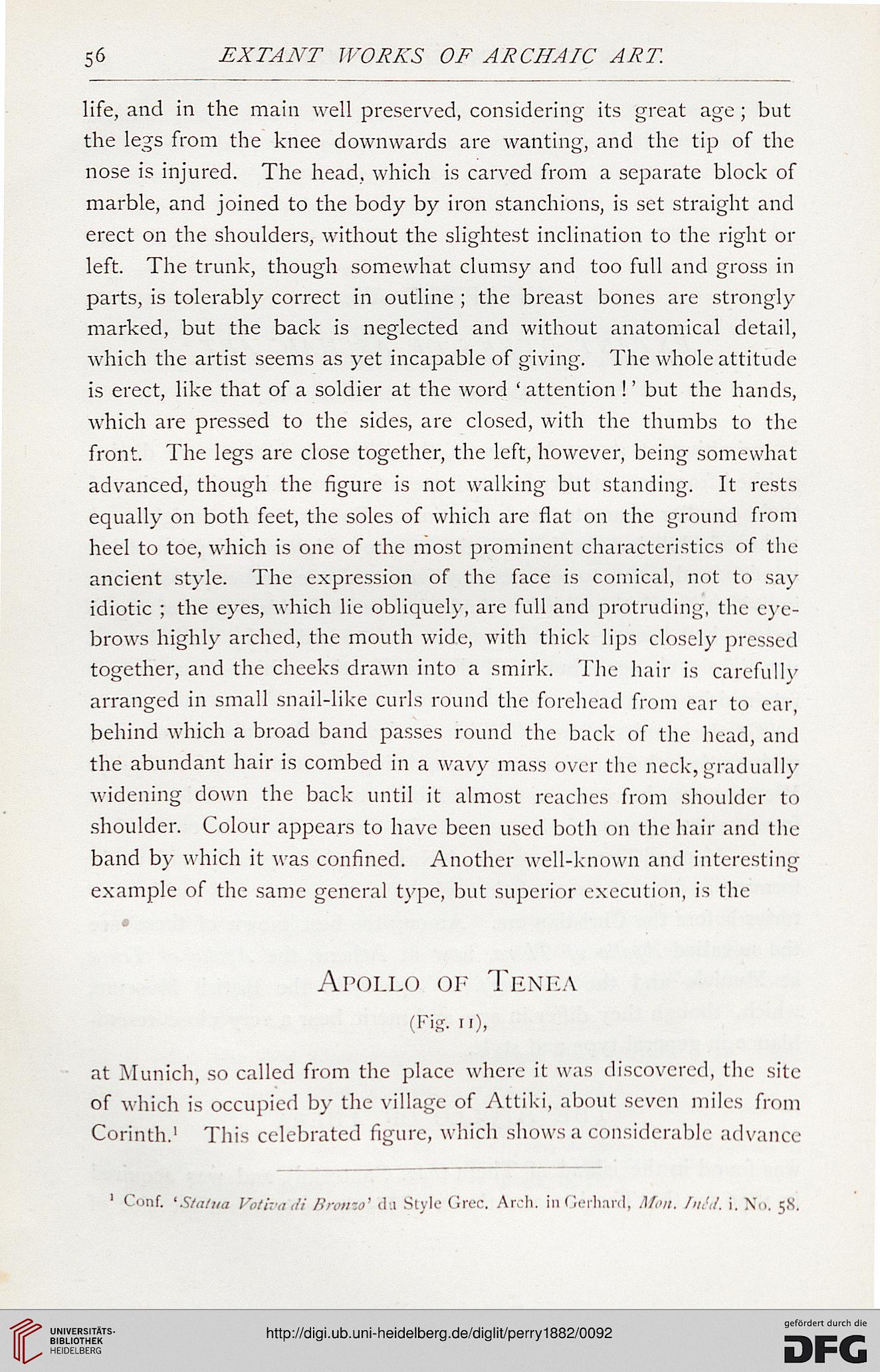56
EXTANT WORKS OF ARCHAIC ART.
life, and in the main well preserved, considering its great age ; but
the legs from the knee downwards are wanting, and the tip of the
nose is injured. The head, which is carved from a separate block of
marble, and joined to the body by iron stanchions, is set straight and
erect on the shoulders, without the slightest inclination to the right or
left. The trunk, though somewhat clumsy and too full and gross in
parts, is tolerably correct in outline ; the breast bones are strongly
marked, but the back is neglected and without anatomical detail,
which the artist seems as yet incapable of giving. The whole attitude
is erect, like that of a soldier at the word ' attention !' but the hands,
which are pressed to the sides, are closed, with the thumbs to the
front. The legs are close together, the left, however, being somewhat
advanced, though the figure is not walking but standing. It rests
equally on both feet, the soles of which are flat on the ground from
heel to toe, which is one of the most prominent characteristics of the
ancient style. The expression of the face is comical, not to say
idiotic ; the eyes, which lie obliquely, arc full and protruding, the eye-
brows highly arched, the mouth wide, with thick lips closely pressed
together, and the cheeks drawn into a smirk. The hair is carefully
arranged in small snail-like curls round the forehead from car to car,
behind which a broad band passes round the back of the head, and
the abundant hair is combed in a wavy mass over the neck, gradually
widening down the back until it almost reaches from shoulder to
shoulder. Colour appears to have been used both on the hair and the
band by which it was confined. Another well-known and interesting
example of the same general type, but superior execution, is the
Apollo of Tenea
(Fig. ii),
at Munich, so called from the place where it was discovered, the site
of which is occupied by the village of Attiki, about seven miles from
Corinth.1 This celebrated figure, which shows a considerable advance
1 Conf. 'Sta/ua Votiva'di ffrctno' 3d Style Grec. Arch, in Gerhard, Afon. Tttid. i. No. 58,
EXTANT WORKS OF ARCHAIC ART.
life, and in the main well preserved, considering its great age ; but
the legs from the knee downwards are wanting, and the tip of the
nose is injured. The head, which is carved from a separate block of
marble, and joined to the body by iron stanchions, is set straight and
erect on the shoulders, without the slightest inclination to the right or
left. The trunk, though somewhat clumsy and too full and gross in
parts, is tolerably correct in outline ; the breast bones are strongly
marked, but the back is neglected and without anatomical detail,
which the artist seems as yet incapable of giving. The whole attitude
is erect, like that of a soldier at the word ' attention !' but the hands,
which are pressed to the sides, are closed, with the thumbs to the
front. The legs are close together, the left, however, being somewhat
advanced, though the figure is not walking but standing. It rests
equally on both feet, the soles of which are flat on the ground from
heel to toe, which is one of the most prominent characteristics of the
ancient style. The expression of the face is comical, not to say
idiotic ; the eyes, which lie obliquely, arc full and protruding, the eye-
brows highly arched, the mouth wide, with thick lips closely pressed
together, and the cheeks drawn into a smirk. The hair is carefully
arranged in small snail-like curls round the forehead from car to car,
behind which a broad band passes round the back of the head, and
the abundant hair is combed in a wavy mass over the neck, gradually
widening down the back until it almost reaches from shoulder to
shoulder. Colour appears to have been used both on the hair and the
band by which it was confined. Another well-known and interesting
example of the same general type, but superior execution, is the
Apollo of Tenea
(Fig. ii),
at Munich, so called from the place where it was discovered, the site
of which is occupied by the village of Attiki, about seven miles from
Corinth.1 This celebrated figure, which shows a considerable advance
1 Conf. 'Sta/ua Votiva'di ffrctno' 3d Style Grec. Arch, in Gerhard, Afon. Tttid. i. No. 58,




